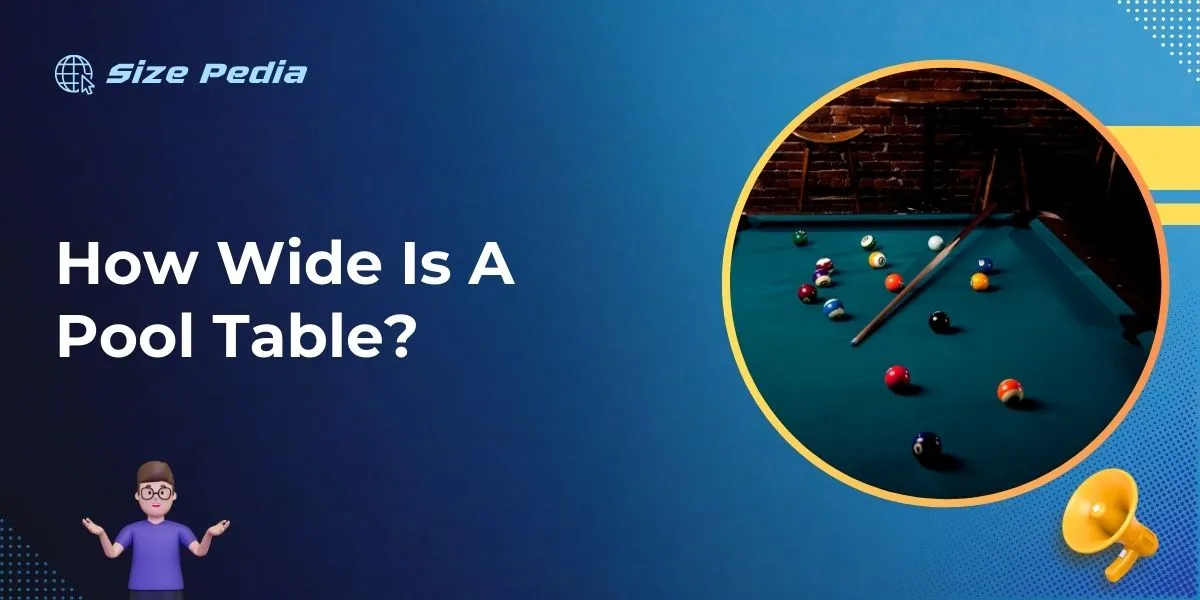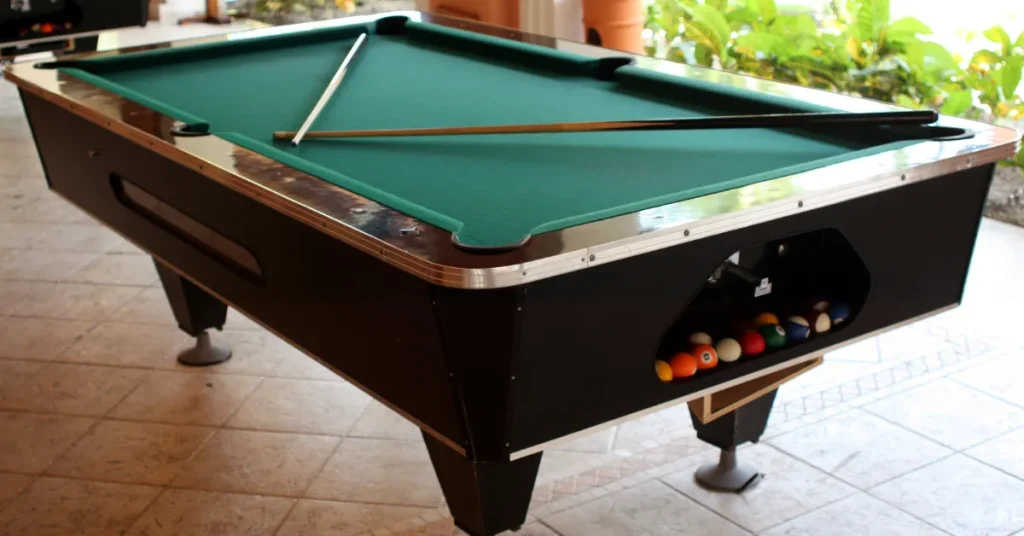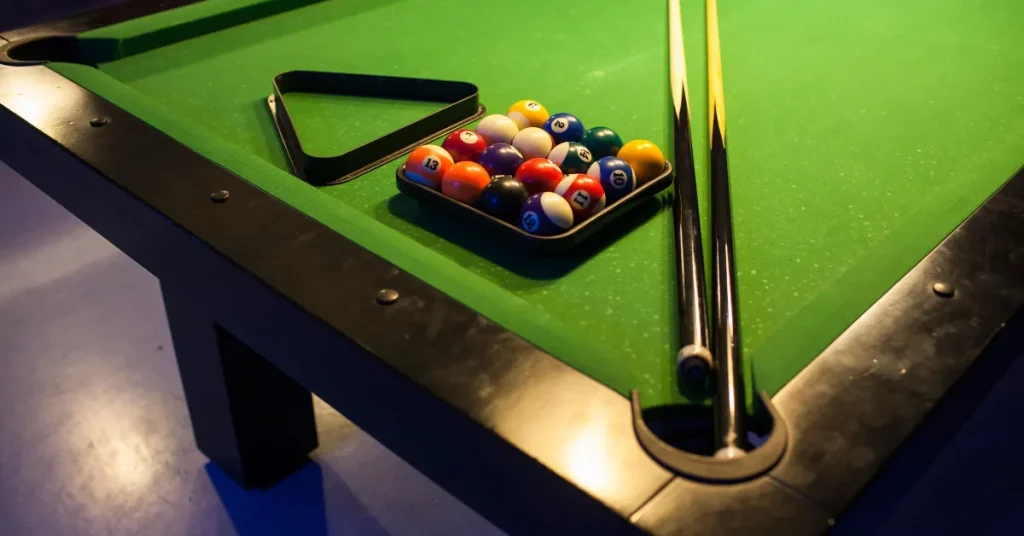A standard pool table is 3.5 feet (1.07 meters) wide. The width varies with the table’s size and model.
Ideal for both casual and serious players, a pool table can be a centerpiece in a game room or a modest addition to a family space. The width of a pool table is crucial for players to maneuver and take their shots comfortably.
Standard pool tables, used in professional play, typically come in two sizes: 7 feet by 3. 5 feet or 8 feet by 4 feet. For aficionados seeking the full experience, regulation-size tables measure a larger 9 feet by 4. 5 feet. Knowing the precise table dimensions is essential for ensuring sufficient room for cues and player movement.
Smaller tables, often found in homes and social venues, also maintain proportionate widths to offer authentic gameplay. Selecting the appropriate width and table size will greatly enhance the enjoyment and functionality of the game.

Standard Pool Table Sizes
Choosing the right pool table size is crucial. Space availability and intended use determine the ideal size. Pool tables come in different sizes, catering to professional players and home enthusiasts. Let’s explore these sizes to find your perfect match.
Professional Vs. Home Use
Professional pool competitions require regulation-size tables. These are usually nine-foot tables. For home use, space often decides the table size. Seven and eight-foot tables are common in home game rooms.
Seven-foot, Eight-foot, And Nine-foot
Seven-foot tables, also known as bar boxes, are popular in bars and homes. Eight-foot tables provide a middle ground for skill improvement. Nine-foot tables are the choice for serious players focused on advanced play.
| Table Size | Play Area | Room Size |
| Seven-Foot | 39″ x 78″ | 13′ x 16′ |
| Eight-Foot | 44″ x 88″ | 13’6″ x 17′ |
| Nine-Foot | 50″ x 100″ | 14′ x 18′ |
- A seven-foot table fits most homes perfectly.
- Eight-foot tables offer a balanced experience for casual and improving players.
- Nine-foot tables are the champions’ choice for mastering the game.
Understanding Regulation Tables
When talking about pool tables, size matters. Specifically, a “regulation” pool table refers to the size used in professional tournaments.
Enthusiasts and serious players aim for regulation-size tables for authentic gameplay. Let’s dive into what makes a pool table qualify as ‘regulation size’ and how it can change the game.
What Qualifies As ‘regulation Size’
A ‘regulation size’ pool table has specific dimensions. The term often causes confusion. It refers to the table’s proportions, not just its size. A true regulation table is twice as long as it is wide.
| Table Length | Table Width | Total Playing Surface |
| 9 feet | 4.5 feet | 100.5 square feet |
| 8 feet | 4 feet | 32 square feet |
A table with these dimensions offers the playing area endorsed by the WPBA and used in official tournaments.
Impact On Gameplay
Playing on a regulation size table can significantly affect a player’s game. Below are key points detailing how:
- Precision: The larger surface requires more accuracy.
- Shot Technique: Longer distances demand better control and power.
- Strategy: With more space, strategic gameplay becomes critical.
A regulation table challenges players and elevates their game to professional standards. Whether you are training for competition or seeking to improve your skills, playing on a regulation size table offers an indisputable advantage.
Space Requirements
Choosing the right pool table means measuring your space. A pool table needs room beyond the edges for players to cue comfortably.
Without enough space, your games won’t be as fun or easy. Let’s look at the minimum room dimensions and the importance of cue space for ensuring a good pool table fit.
Minimum Room Dimensions
Key dimensions depend on the size of the pool table. Here’s a quick guide to help you measure:
| Table Size | Minimum Room Size |
| 7-Foot Table | 17ft x 13.5ft |
| 8-Foot Table | 18ft x 14ft |
| 9-Foot Table | 19ft x 14.5ft |
These measurements ensure there’s enough room to move and make shots without restriction. Measure your space before picking a table size.
Importance Of Cue Space
The cue stick also needs space. A standard cue stick is typically 58 inches long. Players require ample space to extend the cue stick fully for the best gaming experience.
- Players should swing the cue without hitting walls.
- Space around the table allows for free movement.
- Adequate cue space prevents accidents and damage.
Follow these simple space guidelines and enjoy endless pool games with friends and family!
Types Of Pool Games And Their Table Dimensions

Knowing the dimensions of pool tables helps players pick the right game. Pool games come in varieties. Each has unique table sizes. It’s essential for the game’s rules and play style. Here we’ll discuss different pool games and their specific table dimensions.
Eight-ball And Nine-ball Differences
Eight-ball and nine-ball are popular pool games. They often use the same tables. However, they have different rules and ball counts. The common table size is 4.5 by 9 feet. But, tables for both games also come in smaller sizes, like 3.5 by 7 feet and 4 by 8 feet.
- Eight-Ball: A game with 15 object balls plus a cue ball.
- Nine-Ball: A game with only 9 object balls and a cue ball.
| Game | Table Size (feet) |
| Eight-Ball | 4.5 x 9 |
| Nine-Ball | 4.5 x 9 |
Snooker And Carom Billiards
Snooker and Carom billiards demand different tables. Snooker typically requires a larger 6 by 12 feet table. It features smaller pockets and different balls. Carom billiards doesn’t use pockets. Its standard table size is around 5 by 10 feet.
Each game’s table has a specific felt and cushion for optimal play.
- Snooker tables are green with flat cushions.
- Carom billiards tables are green or blue with angled cushions.
| Game | Table Size (feet) | Pockets |
| Snooker | 6 x 12 | Yes |
| Carom Billiards | 5 x 10 | No |
Custom Tables And Unconventional Sizes
Pool enthusiasts often dream of owning a table that fits their unique space. Custom tables and unconventional sizes bring personality to a game room.
Yet, they come with their own set of considerations. Let’s explore the possibilities and potential hurdles of bespoke billiard tables.
Options For Customization
Custom pool tables break the mold of standard sizes. They can be tailored to fit any room. Here are popular custom options:
- Size: From mini to oversized, match the table to your space.
- Design: Choose unique colors, materials, and leg styles.
- Features: Add a dining top, LED lights, or a ball return system.
Selecting these options ensures your pool table is one of a kind.
Challenges With Non-standard Tables
With uniqueness comes certain challenges. Here’s what to consider:
- Space: Ensure ample room for cues around the table.
- Playability: Non-standard sizes can affect game dynamics.
- Accessories: Custom sizes may require custom cue sizes.
It’s important to weigh these factors before choosing a non-standard table.
Tips For Choosing The Right Size

Finding the perfect pool table size involves a little more than admiring its look. Your room size, gameplay style, and personal preferences all matter. Use these tips to select a pool table that fits just right and provides years of fun.
Considerations For Purchasing
Before buying a pool table, think about these crucial elements:
- Room Size: Measure your space. A large table won’t fit in a small room. Allow for cue space around the table.
- Table Size: Standard tables come in various widths. Choose from 7, 8, or 9 feet. Kids and beginners do great with smaller sizes.
- Style & Budget: Pool tables range from basic to luxurious. Pick one that suits your style without breaking the bank.
- Play Frequency: Get a durable table if you play often. Occasional players can opt for less expensive models.
Maintaining Your Table’s Surface
Keep your pool table looking and playing like new with these tips:
- Cover Up: Use a cover to protect the felt from dust and damage.
- Regular Cleaning: Brush the surface gently to remove debris. Use a soft vacuum setting if needed.
- Avoid Moisture: Never place drinks on the table. Spills can ruin the felt.
- Professional Resurfacing: Hire professionals for resurfacing. They ensure the surface stays smooth and flat.
FAQs About How Wide Is A Pool Table
How Wide Is An 8ft Pool Table?
An 8ft pool table typically measures about 4. 5 feet in width. This standard size ensures ample playing space for a full game of pool.
How Much Room Space Needed For Pool Table?
Ensure at least 5 feet of space around all sides of the pool table for comfortable play. This space accommodates cue stick movement and player positioning. For example, a 9-foot table typically requires a room measuring 18 by 14 feet.
What Size Is A Full Size Pool Table?
A full-size pool table typically measures 9 feet by 4. 5 feet, or 2. 74 meters by 1. 37 meters.
What Is The Width Of A 7ft Pool Table?
The typical width of a 7ft pool table is approximately 3. 5 feet or 42 inches.
Conclusion
Understanding pool table dimensions is crucial for both enthusiasts and casual players. It ensures a perfect fit for your space and an optimal playing experience.
Now that you’re equipped with the knowledge of pool table widths, you’re ready to make an informed decision whether you’re buying, playing, or simply curious about the game’s essentials.
Remember, a well-sized table can significantly enhance your enjoyment of billiards.
Resources:
1. https://www.sturbridge.gov/board-selectmen/pages/billiardspool-table-license
